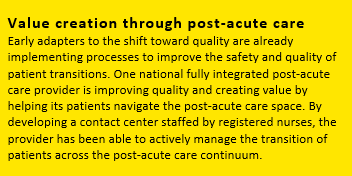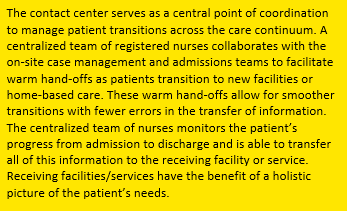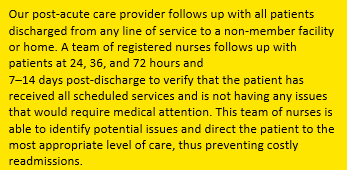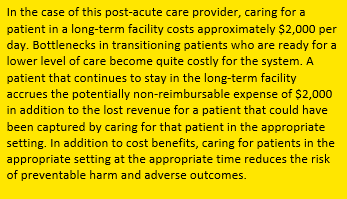The Affordable Care Act introduced several provisions to regulate quality reporting and offer financial incentives to reward hospitals and physicians for delivery of high-quality care. The 1999 study “To Err is Human”1 called attention to the fact that over 98,000 patients per year suffered from preventable harm caused by the health care system. Since then, health systems, payers and regulatory agencies have made a concerted effort to improve and incentivize safe, affordable, high-quality health care.

Significant progress has been made over the last decade, but much work remains to be done. One of the most vulnerable, dangerous times in the patient care continuum is during the transition from one level of care to the next. During these transitions, patients are susceptible to medical errors resulting from incomplete or imprecise communication, omissions of pertinent information, and other documentation errors. This leaves patients vulnerable to exacerbations of illness and prolonged convalescence. This is commonly seen when transitioning into home-based care, where an individual may lack the basic social and economic support required to manage their health. Coordination of care and partnerships at this critical juncture through the continuum can also prevent unnecessary ED visits and acute care readmissions. Continuum-based, integrated models of care coordination represent an opportunity to enhance safe, coordinated transitions resulting in better patient care, improved outcomes, reduced costs, and fewer preventable errors and readmissions.
Better patient care: connected transitions through continuum-based care coordination

Approximately one in four Americans suffer from two or more chronic conditions.2 The presence of co-morbidities increases the risk for complications during care transitions. In these situations, the value of ongoing, continuous care coordination is amplified. The risk of preventable harm during transitions increases with comorbidity and polypharmacy issues. This growing, high-acuity population is more likely to require more movements and transition as they progress along the continuum. During these moves, it is critical that accurate and appropriate information is transmitted to subsequent providers and caregivers. Continuum-based coordination of care connects patients, and their caregivers, with the patient’s primary and specialty care providers as well as other critical health system resources. Care coordinators serve as patient advocates providing additional insight during a change in care setting while also proactively addressing potential complications. Through ongoing monitoring of patient needs and coordinated communication across the continuum, patients are safeguarded from preventable harm arising from incomplete, inaccurate or imprecise information. Additionally, the presence of care coordinators provides an additional opportunity for social, cultural and other relevant considerations to be communicated and integrated into the patient’s care plan.
Healthier individuals and communities: post-discharge follow-up and home-based care
Transitioning to home-based care can be a daunting situation. When patients and their caregivers are faced with a plethora of instructions and medications to manage, simple tasks can become overwhelming and lead to complications in recovery. Telephonic case management allows care coordinators to interact with patients even after they have been discharged from acute care.

These pointed interactions can assist in timely identification of issues that may warrant intervention, preventing readmissions and unnecessary ER visits while keeping the patient’s care aligned to their individual goals. Performing this function with scripts and algorithms tailored to the patients’ care needs and disease state(s) can assist care coordinators in identifying early indicators of complications, communicate emerging needs with providers and facilitate appropriate intervention that improves clinical outcomes. Telephonic monitoring and support is an effective strategy for keeping patients in their residence while reducing anxiety and treatment plan errors.
Smarter spending: right care, right time  Inefficient resource utilization is a cost driver in any industry. However, in health care, the costs of misuse can be more than financial and may result in clinical complications and adverse outcomes. When care is not coordinated and patients are not supported with services at the appropriate level of care, the risk for preventable harm increases. Not transitioning patients at the appropriate time can impede their progress toward recovery and expose them to potential complications, including infections. Additionally, providers and health care systems leave themselves financially vulnerable for charges that may not be reimbursed based on length of stay or acuity guidelines and lost revenue for the resources currently being used inefficiently. By supporting timely patient transitions with coordination of care, supported appropriately with tailored telephonic monitoring, we can reduce instances of preventable harm, improve outcomes and reduce costs.
Inefficient resource utilization is a cost driver in any industry. However, in health care, the costs of misuse can be more than financial and may result in clinical complications and adverse outcomes. When care is not coordinated and patients are not supported with services at the appropriate level of care, the risk for preventable harm increases. Not transitioning patients at the appropriate time can impede their progress toward recovery and expose them to potential complications, including infections. Additionally, providers and health care systems leave themselves financially vulnerable for charges that may not be reimbursed based on length of stay or acuity guidelines and lost revenue for the resources currently being used inefficiently. By supporting timely patient transitions with coordination of care, supported appropriately with tailored telephonic monitoring, we can reduce instances of preventable harm, improve outcomes and reduce costs.
EY is poised to assist our clients in reducing preventable harm, improving the efficiency of resource utilization and ultimately creating healthier patients and communities through our Cost Optimization service offerings. To learn more please visit ey.com/valuedrivencare.
1 The Institute of Medicine – To Err is Human – http://www.nationalacademies.org/hmd/~/media/Files/Report%20Files/1999/To-Err-is-Human/To%20Err%20is%20Human%201999%20%20report%20brief.pdf
2 Ward BW, Schiller JS, Goodman RA. Multiple chronic conditions among US adults: a 2012 update. Prev Chronic Dis. 2014;11:E62
The views, opinions and positions expressed within these guest posts are those of the author alone and do not represent those of Becker’s Hospital Review/Becker’s Healthcare. The accuracy, completeness and validity of any statements made within this article are not guaranteed. We accept no liability for any errors, omissions or representations. The copyright of this content belongs to the author and any liability with regards to infringement of intellectual property rights remains with them.
